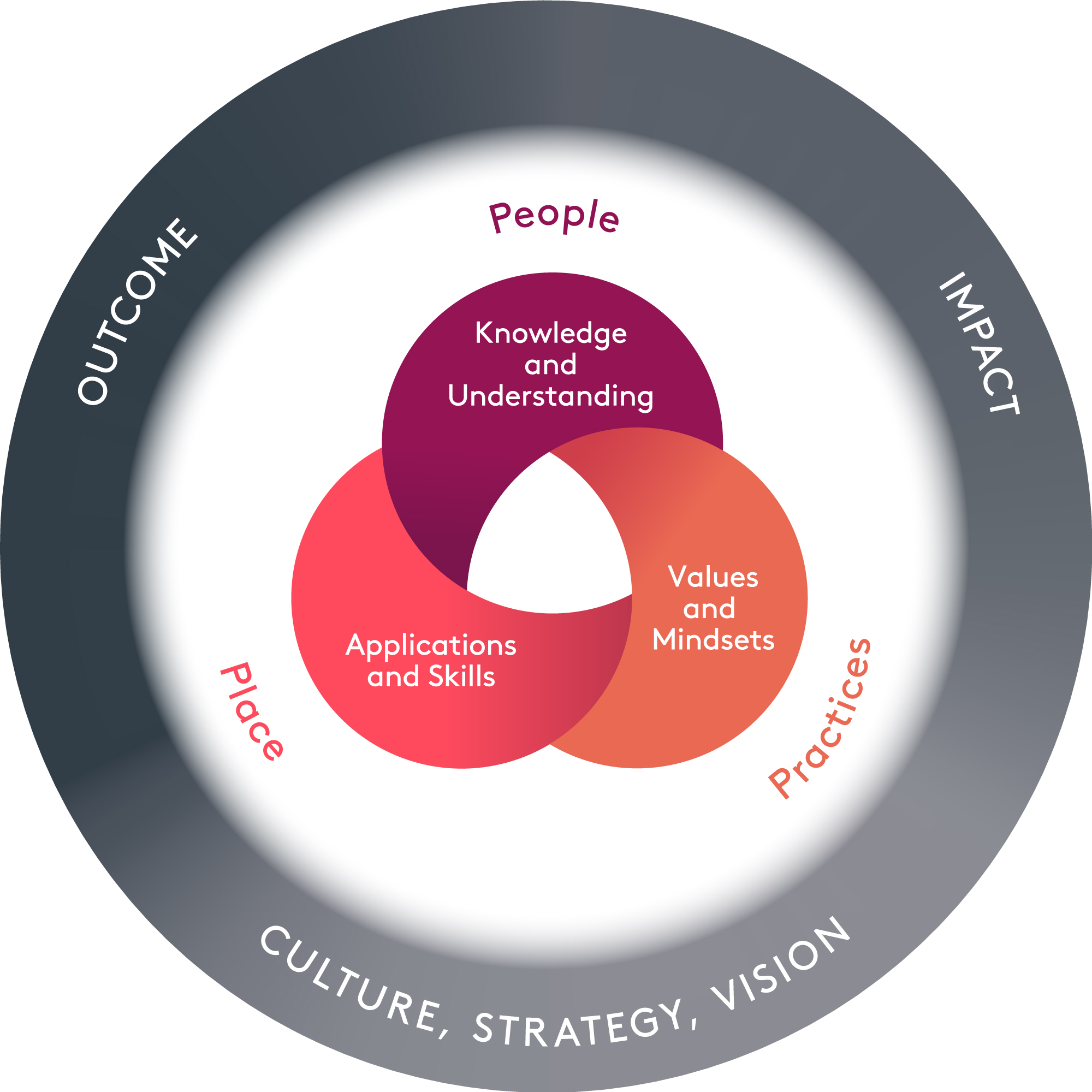We all know higher education has undergone a seismic shift from being a stable, traditional environment in the late twentieth century to a dynamic, complex and fast-moving sector. This transformation isn’t only in the UK – it’s global as well.
Leaders in higher education are now tasked with navigating political and regulatory changes, financial pressures, shifts in social dynamics and technological advancements. And that’s before they are faced with enhancement challenges like building student experience initiatives or boosting research impact.
In the past, leadership has perhaps been viewed as something of an anathema in academia, but its importance today permeates every level of an organisation. It is now a crucial component in the higher education sector’s efforts to successfully navigate current challenges.
We’ve created the Framework for Leading in Higher Education to address these multifaceted issues which can’t be left to executive teams alone. What’s needed most is a joined-up approach, engaging formal and informal leaders right across the institution. The mission, vision and values need to feel intuitive and fitting, so that, in an ideal world, everyone would want to frame their actions around the strategic plans to meet them and to feel part of the bigger picture. And this alignment must be two-way, fostering a sense of ownership and inclusivity, whether it’s about building inclusive cultures or understanding financial imperatives.
The journey to the framework
The story of our framework began in 2021 when Doug Parkin, former Principal Consultant at Advance HE and a research team led by Richard Watermeyer from the University of Bristol asked a deceptively simple question: “what works for leadership in higher education?” This question sparked a literature search and a scoping study, engaging leaders at all levels and functions from around the world. This was followed by Advance HE’s Leadership Survey, published in 2023.
After the report’s publication, we convened a rather brilliant steering group of colleagues from the UK, Australia and the Middle East, chaired by Ben Calvert, vice chancellor at the University of South Wales, and Shân Waring, vice chancellor at Middlesex University. We engaged with the sector through roundtables and workshops in the UK, Australia and Southeast Asia initially, to understand if a framework was wanted and then to determine its details.
The desire for a framework was clear.
We heard repeatedly about the importance of elevating leadership as a career path alongside research or teaching and supporting learning. The need for a common understanding and vocabulary around higher education leadership came across loud and clear.
In the back of our minds throughout all of this was a sense of disconnection between people and institutions. A sense that, sometimes, leadership is like wading through treacle with an intensity of policies, regulations and workload holding us back from being the leaders that we want to be. Unfortunately, the framework can’t shift all the treacle, but it might help find some pathways through, help to join-up thinking across institutions and help us to make friends with the structures, strategies and resources that are needed to sustain the whole organisation.
Who’s it for?
The framework is designed for leaders, aspiring leaders and those involved in leadership and organisational development. It’s intended for a global audience, recognising the many ways to lead in higher education across diverse cultures, contexts, structures and institutions.
Leadership happens throughout an institution, and this framework enables engagement from leaders operating formally and informally, from institutional to individual contributors, and from aspiring leaders to highly experienced ones. It’s designed to be inclusive in terms of culture, geography, institution type, level of responsibility, experience, and function.
The framework explained

At the core of the framework are three sets of leadership attributes, encompassing “knowledge and understanding”, “values and mindsets”, and “skills and applications”. Each of these is broken down into five dimensions for deeper exploration.
Moving outward, the framework articulates the context in which the leader operates: place, people and practice. The outer ring, intentionally blurred to remind us that the lines between individual attributes, context and institutional goals are never clearly defined, and that disruption is most likely to occur in those grey zones.
We’ve then defined three essential functions of university leadership as:
- Developing, defining, and operating within organisational culture, strategy and vision: recognising that these will undoubtedly shape you as a leader as they are shaped by you.
- Achieving internal measurable outcomes: performance and quality, financial sustainability, employability, curriculum quality and relevance, student and staff attraction, retention, progression, partnerships and collaborations, research and knowledge exchange.
- Generating impact on the external world: generating local growth, reputation, addressing and solving global problems, creating economic value, developing cultural capital, social mission and graduate impact.
You might be tempted to ask, “is everyone supposed to do all of that?” To which, thankfully, the answer is no.
This is an all-encompassing framework, and not all leaders will engage with every aspect. Less experienced leaders might focus on a few of the dimensions, while senior leaders might engage across all of them. Similarly, not everyone will be involved in every function of the outer circle, but everyone will be directly or indirectly involved in some aspects.
How to use the framework
Leaders seeking self-development might use the framework for individual reflection, considering their strengths and areas for development, and how their organisation’s people, places and practices support or impede their progress. New leaders might use the framework to understand leadership in the context of higher education, considering their strengths and experiences, and how these contribute to the outer wheel’s functions. Leaders preparing for promotion might reflect on past impacts, connect them to leadership attributes, and identify further development needs.
Team leaders and leadership developers might assess team strengths and attributes, understand how context shapes performance, and use the framework for future-focused conversations. Institutions might use this framework to inform their own context-specific leadership frameworks and development programs.
Organisation development and learning and development professionals might consider the cultural and development needs of their leaders, ideally in consultation with them, to determine necessary structures and interventions for succession planning or responding to change initiatives.
What’s next?
We’ll be launching the framework over several months, with podcasts, interviews, seminars and workshops in the UK, Australia, Europe and the Middle East.
We want the sector to experiment, test it out, and help us shape it into something that will have a lasting impact. In the future, we’re looking at building accreditation to recognise those leading in higher education, similar to how we currently recognise those in teaching and supporting learning with the Professional Standards Framework.
We welcome thoughts, suggestions and feedback on this as well. And if you are involved in research activities in this area, we’d be delighted to hear from you.
Find out more about the Framework for Leading in Higher Education.













